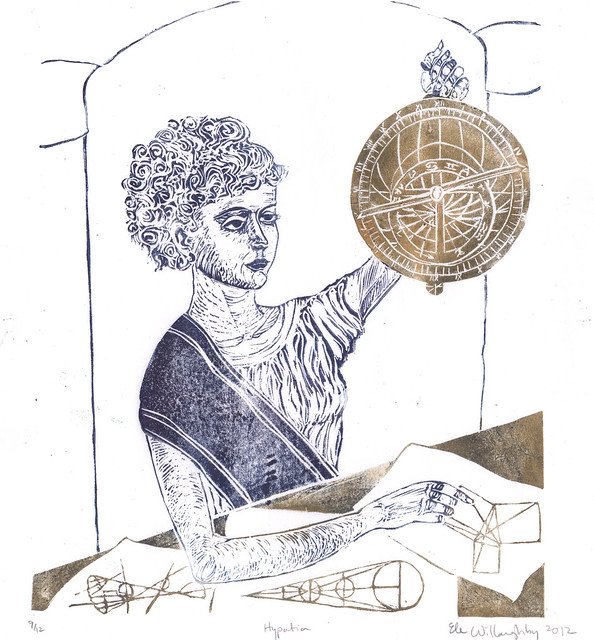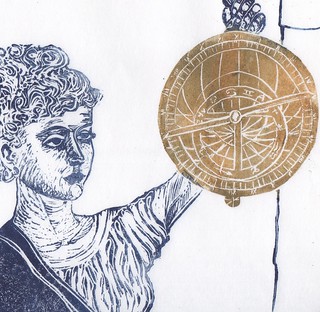
Hypatia was the amongst the earliest woman mathematician recorded in Western history. This is my imagined portrait of her in a first edition linocut print in copper and purple-blue on lovely Japanese kozo (or mulberry) paper, 12.5 inches by 12 inches (31.7 cm by 30.5 cm). There are 12 prints in the edition.
Hypatia lived in the 3rd century AD in Alexandria, Egypt, which was part of the Roman Empire. She was born at some time between about 350 and 370 and died in 415 C.E. She was the head of school, where she taught Neoplatonist philosophy, astronomy and mathematics. She believed in empiricism and natural law. She was the daughter of a famous mathematician, Theon Alexandricus (ca. 335–405), with whom she worked and published edited versions of Classical texts in mathematics. She also pursued her education in Athens and Italy before returning to Alexandria.
It is difficult to precisely specify her own contributions to mathematics, since many documents have been lost and it was the tradition of the time to write commentaries on the great texts of Classical mathematics. These were essentially edited or annotated versions, which may have included corrections and new material, but which were known by the name of the original author. Also, her work and her father's work may be confused and conflated. This confusion of attribution is common for female scholars of the Classical world. It is known that she wrote commentaries on 13-volume Arithmetica by Diophantus, the Conics of Apollonius, and edited Ptolemy's Almagest and on Euclid's Elements. I've alluded to these in my print; the diagrams on her table, from right to left, show conic sections, Hipparchus' construction to calculate the distances to the Sun and Moon (which was part of Ptolemy's Almagest), and some basic Euclidean geometry. She is also credited with a more efficient means of doing long division - which is no mean feat when you recall she was using Roman numerals!
 She charted heavenly bodies. She built and instructed her pupils in the design and use of the astrolabe. The astrolabe, like the one she is holding in the print, was central to astronomy and navigation from antiquity through the Renaissance. It allowed people to measure the inclination of celestial bodies and could be used to locate or predict the positions of the Sun, Moon, planets, and stars, determine local time given local latitude and vice-versa, or for surveying and triangulation. You can see the outer circle is notated with the 24 hours of the day (in Roman numerals) and the inner circle with the symbols for the contellations of the Zodiac. Thus, she was not only a mathematician, but what we would today call an astronomer, a physicist and an engineer.
She charted heavenly bodies. She built and instructed her pupils in the design and use of the astrolabe. The astrolabe, like the one she is holding in the print, was central to astronomy and navigation from antiquity through the Renaissance. It allowed people to measure the inclination of celestial bodies and could be used to locate or predict the positions of the Sun, Moon, planets, and stars, determine local time given local latitude and vice-versa, or for surveying and triangulation. You can see the outer circle is notated with the 24 hours of the day (in Roman numerals) and the inner circle with the symbols for the contellations of the Zodiac. Thus, she was not only a mathematician, but what we would today call an astronomer, a physicist and an engineer.She met a terrible end. She became embroiled in a dispute between the Prefect and the Christian Patriach, later known as Saint Cyril, who spread rumors that she was a witch who had cast spells on the Prefect. Scolasticus, a contemporary Christian writer, wrote that she was kidnapped on her walk home, taken to a church, where she was stripped and torn limb from limb and then burned by an angry mob of Christians lead by a fanatic. News of her murder lead the community to be condemned. Scholasticus comments, "Surely nothing can be farther from the spirit of Christianity than the allowance of massacres, fights, and transactions of that sort".
Because of her violent and scandalous death, her story has been used by many groups of people with many competing interpretations of its meaning. She has been claimed by competing sects of Christian (who either defend or defame her) throughout history, Pagans, Wiccans, and feminists as a symbol. Somewhat ironically, though she was accused of being a Pagan "devoted at all times to magic, astrolabes and instruments of music, and she beguiled many people through her Satanic wiles" by the 7th-century Egyptian Coptic bishop John of Nikiû, she was later employed by Christians as a symbol of Virtue. She has appeared in literature, art, graphic novels (Alan Moore's Promethea) and cinema (including Agora (2009), by Alejandro Amenábar, staring Rachel Weisz) . Her murder has been called the first witch hunt, the end of Classical Antiquity and the beginning of the Dark Ages - but these claims are not well-founded in the actual historical events.
Chances are that many of these proponents of Hypatia and claims by various groups that she was one of their own are not really representative of the historical Hypatia, so much as her symbolic power. There is no unbiased contemporary evidence that she was either a true Pagan or a witch. She was a Neoplatonist, which was both a spiritual and philosophical tradition, so not truly a staunch secularist either. For all the competing Christian claims (Catholic versus Orthodox, Protestant versus Catholic, churches of Constantinople versus Alexandria) or the view that she was a tragic victim of the Church's conquest of science of the time, it seems likely that she was a political pawn in a battle between Patriarch and Prefect. But, it is very hard not to see that from the earliest known instance, a woman who excelled in science and math was the object of jealously, treachery, accusations of witchcraft and, in far too many cases, violence and murder. Though, she was not the only Classical woman in philosophy and mathematics and those who came before and those who followed did not share her terrible fate.
It was her fate which lead to her lasting fame but it is her achievements that should be remembered. One contemporary claimed she outshone her father, regarded the best mathematician of his generation. Perhaps most importantly, she preserved the mathematical heritage of ancient Greece and Roman and was talent and respected teacher. She was known to wear the robes of a scholar, usually reserved for men, as was the role she took as philosopher, mathematician and advisor to the leaders of her day. As Scholasticus wrote:
"There was a woman at Alexandria named Hypatia, daughter of the philosopher Theon, who made such attainments in literature and science, as to far surpass all the philosophers of her own time. Having succeeded to the school of Plato and Plotinus, she explained the principles of philosophy to her auditors, many of whom came from a distance to receive her instructions. On account of the self-possession and ease of manner which she had acquired in consequence of the cultivation of her mind, she not infrequently appeared in public in the presence of the magistrates. Neither did she feel abashed in going to an assembly of men. For all men on account of her extraordinary dignity and virtue admired her the more"
[Edited for accuracy February 3, 2022]









No comments:
Post a Comment